Nof S.Y. Springer Handbook of Automation
Подождите немного. Документ загружается.


Automation in Education/Learning Systems 85.2 Examples 1515
Table 85.5 The curriculum on production planning (MRP)system
Curriculum
First lesson Second lesson Third lesson
The framework of MRP systems Review of the previous lesson Review of the previous lesson
Relationship between the product Master production scheduling (MPS): Overall MRP system framework:
and its demand and inventory: (a) Input information (a) MRP framework for MPS
(a) Required parts and their lead time (b) Output information and capacity planning
(b) Production and ordering points (c) Calculation method
based on lead time (d) Example
(c) Lot size and inventory
Inventory control: MRP calculation mechanism: Product, its demand and inventory:
(a) Definition (a) The mechanism of MRP (a) Product structure
(b) The change in inventory (b) Calculation method and its lead time
(c) Relationship among order volume (c) Example (b) Reorder point based
and inventory cost, order cost on lead time
and total cost (c) Lot size and inventory
Influencing factors on master Lot-sizing rules: Overall MRP system execution:
production scheduling (MPS): (a) Lot-for-lot rule (a) Creating production plan
(a) Cost parameters (b) Economic order quantity rule based on MPS
(b) Lead time (c) Period order quantity rule (b) Based on the production plan,
(c) Changes in demand (d) Minimum cost planning rule create MRP plan for all parts
(c) Minimizing the costs
have achieved in the practice. In this case, through on-
line discussion, learners can submit theircomment, tips,
and/or questions to the BBS, allowing other learners to
view them. Therefore, a more communicative lesson is
enable, while atthe same timemaintaining personal(not
group) learning to avoid dependency on the learning
environment.
Example of Learning Contents
of Material Requirements Planning (MRP)
in the System Course Unit
An example of new numerical simulation software to
support problem-solving learning e-Learning, within
material requirements planning (MRP)inthesystem
course unit is introduced in this section. The PBL
e-Learning method utilizes an established local-area
network system to allow learners to access directly the
numerical simulation software through the LMS during
the course. The introduced software is specifically de-
sign to support the MRP system course. The software
is intended to reduce the calculation effort, allow learn-
ers to switch their effort in generating a more efficient
production plan, and improve their interest in the sub-
ject. The final objective is to improve the knowledge
and skill attained during the course that uses the new
learning method.
Overview of the Material Requirements Planning
(MRP)CourseUnit.
Material requirements planning
(MRP) systems, a technique in production planning and
inventory control system [85.79,80], are widely used in
companies nowadays. Practical education programs in
production planning (e.g., MRP system) are expected
by companies from new workers. In order to answer
this demand, in a series of cyber manufacturing pro-
grams in the industrial engineering and information
management field, learners are required to understand
MRP system, along with other techniques such as in-
ventory planning, project management techniques, and
manufacturingresources planning.Generally, the objec-
tives of this course unit are to develop the necessary
knowledgeand abilityto designa reasonable production
Part I 85.2
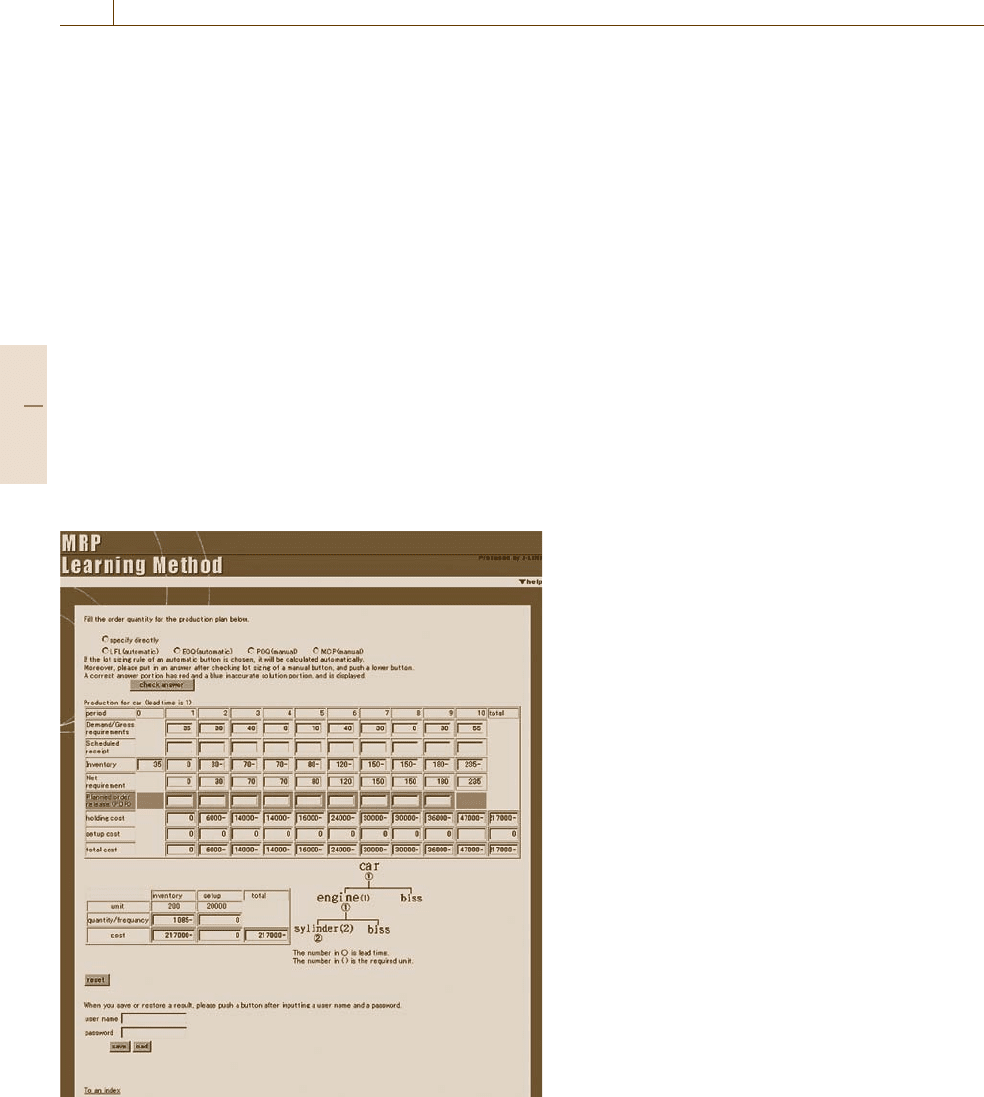
1516 Part I Home, Office, and Enterprise Automation
planning, by taking all necessary factors into consider-
ation.
The curriculum for e-Learning method on MRP sys-
tem proposed here is shown in Table 85.5 [85.81]. The
MRP course unit requires three learning lessons. Each
lesson consists of 90min lesson time, during which
instructors describe the required theories, and 90min
practice time, during which the learners have to ac-
complish the practice prepared beforehand using the
numerical simulation software to help them. The main
objective of this e-Learning method is to improve the
knowledge and skill attained during the course. Ac-
cordingly, the software is also prepared to have three
separate practice problems, each corresponding to one
lesson.
Master Production Schedule (MPS) Planning and Lot
Sizing Rules.
In the second lesson, MPS planning for
the final item is allocated ten periods, as shown in
Fig.85.8. Here, the learners can choose whether to enter
Fig. 85.8 Image of the software used in the MRP systems course
unit
the order quantity directly, or to use one of the avail-
able lot-sizing rules, as illustrated in the upper part in
Fig.85.8. If the learners choose to complete the order
quantity directly, the software will automatically con-
duct other calculations such as on hand inventory, total
setup costs, total holding costs, and total costs. On the
other hand, the software will automatically calculate all
required values if the learner chooses one of the lot-
sizing rules.
The objectives of this second practice are to famil-
iarize the learners with the MPS logic and lot-sizing
rules, to realize trade-off relations between lot-sizing
rules, to realize trade-off relations between holding and
setup costs, and to prepare the user for more compli-
cated MRP in practice 3.
Assessment Method for Learning Efficacy
Stated below are the measures used to collect data of
learning efficacy. Data would be assessed in order to
guarantee the quality of the lectures (previously shown
in Fig.85.5, assessment data of learning efficacy):
1. Measuring the level of understanding (knowledge
level) of the lectures based on the result of a quiz
2. Measuring the level of skill acquisition (skill level)
from the practices based on the results of a report
for each course unit
3. Evaluation of the effectiveness of the course and
the software through data analysis of a previ-
ous questionnaire at the beginning of the course,
a questionnaire for each course unit, and a final
questionnaire at the end of the whole course (the
questionnaire would be open-ended and multiple
choice)
4. Logging of data analysis related to the learning
record in the LMS, such as grade data, BBS discus-
sion records, etc.
The quiz at the end of the theories taught in lec-
tures should evaluate learners’ understanding. The quiz
is of multiple-choice type, so submission and appraisal
of the quiz could be implemented automatically, using
the advantage of the LMS.
The report worksheets are beforehand with each
practical training, and the LMS distributes them. The
learners make their reports by using software of the
system, and have to submit the worksheet to the in-
structor by the LMS before the next start time of lesson.
The admission report is conducted automatically by the
LMS.
Part I 85.2

Automation in Education/Learning Systems 85.2 Examples 1517
Table 85.6 Course objectives and student goals
Course name Course objectives Intended learning outcomes
Quality Acquire the ability to perform quality Incorporate customer needs into the quality management
management control by taking all measures necessary process, identify what actions must be taken to satisfy
(QM) to ensure customer satisfaction and good customer needs, and utilize appropriate methods to solve
quality various problems that exist at the production site
From the standpoint of quality first, identify what
improvements must be made to ensure proper quality
management and use appropriate measures to solve
various problems that exist at the production site
Describe quality management from the perspectives of
the customer satisfaction and quality-first philosophies
Play a leadership role in quality management activities
that are based on customer satisfaction and quality-first
philosophies
Manufacturing Acquire the ability to identify and solve Identify key issues that exist in a given workplace
knowhow (ameliorate) problems that exist at the
Identify and analyze the current status of a given
and creativity manufacturing site
workplace
(MKHC)
Capable of suggesting specific improvement measures
Give a logical explanation of improvement measures
to fellow workers in the workplace, or demonstrate how
such improvements can be implemented to persuade
workers to take action
Capable of applying the above-mentioned knowhow
in any workplace
Knowledge Have a clear understanding of the Capable of achieving standardization and improvement
chain processes involved in creating products in design control
management that meet customer needs and acquire
Capable of achieving standardization and improvement
(KCM) the ability to standardize and improve
in process control
these processes while taking into
consideration the cost and delivery time Capable of achieving standardization and improvement
in purchasing and subcontract management
Capable of achieving standardization and improvement
in cost management
Capable of suggesting how standardization and improve-
ment can be achieved in the above-mentioned manage-
ment activities from the perspective of profit control
Part I 85.2

1518 Part I Home, Office, and Enterprise Automation
Table 85.7 Questionnaire surveys for the purpose of improving the program
Type of Precourse Postsession Course Survey for the Survey for the
questionnaire/ survey survey completion satisfaction participants’
purpose, survey in hosting supervisors
respondents, practical
and timing sessions
of surveys
Purpose To understand To understand To assess the To assess To assess the
the working what aspects participants’ the hosts’ following changes
environment of the course satisfaction with satisfaction with in the course
and the academic sessions need with the course the outcomes of participants
background of to be improved and to identify the improvement as perceived
the participants and to track the what needs measures by participants’
participants’ to be improved supervisors:
progress and • Change in
understanding performance
of the course • Change in
content behavior
• Change in
enthusiasm
and commitment
to fulfill
responsibilities
Respondents Course Course Course Companies Superiors
participants participants participants hosting of the course
the practical participants
training sessions
Timing Before the start At the end Upon Some time after Some time after
of the first session of each session completion the completion the completion
of the course of the course of the course
85.2.2 The Case of an Educational Program
for Manufacturing Managers
Using IT Jigs
Program Objectives
The aim of this educational program [85.7]isto
provide participants with the knowledge and skills re-
quired to manage manufacturing processes employed
by small to medium-sized manufacturers of industrial
machinery in the Hokuriku District of Japan. Class-
room instruction practical exercises will cover the
following:
1. Made-to-order manufacturing and flexible man-
ufacturing systems, both of which are imple-
mented widely by manufacturing companies in the
Hokuriku District to control quality, cost, and lead
time
2. Total optimization (instead of partial optimization)
of all production processes
3. Continuous improvement in the workplace.
Based on these learning goals, three courses and
their course objectives were developed, as shown by
Table 85.6.
Part I 85.2
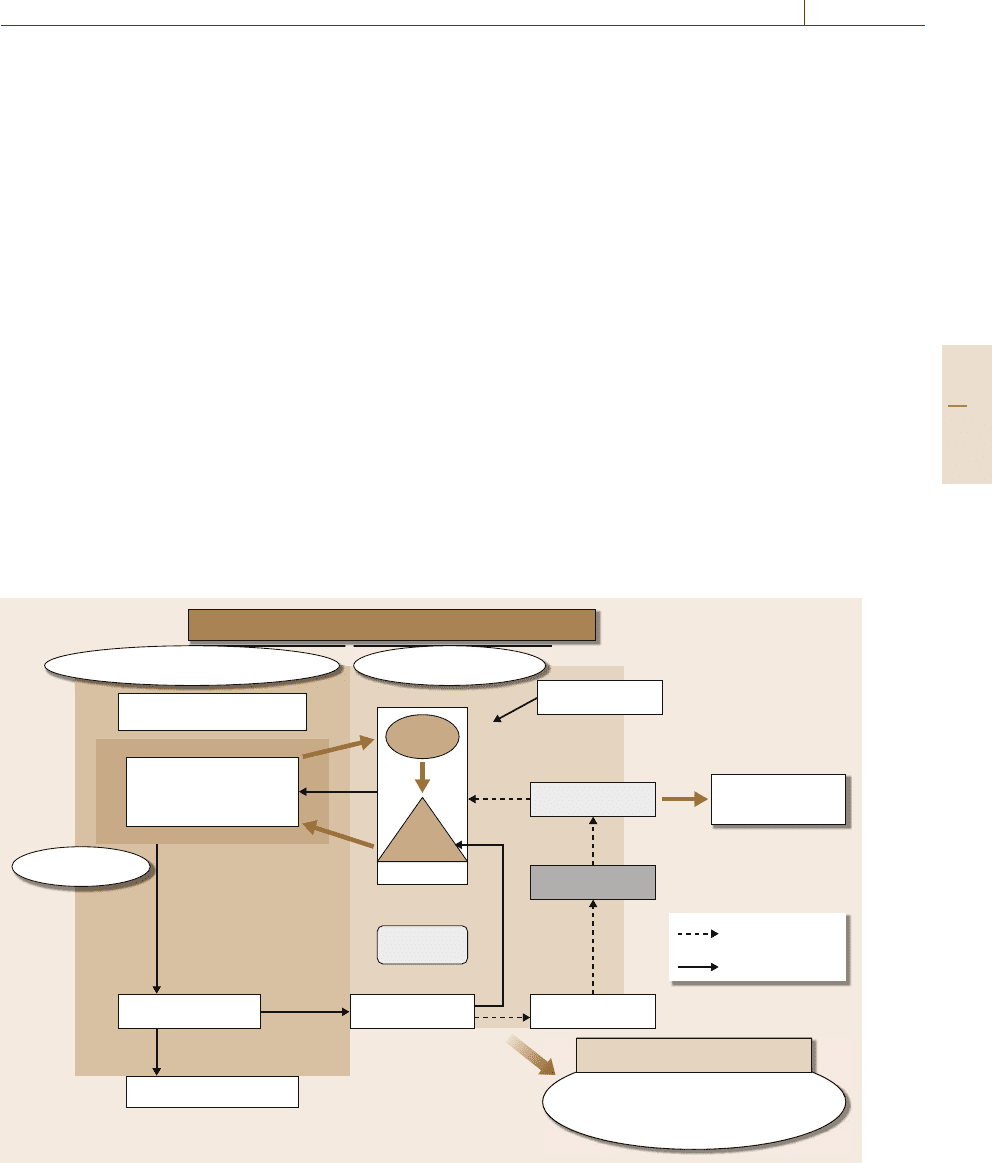
Automation in Education/Learning Systems 85.2 Examples 1519
Program Evaluation Method
Based on Kirkpatrick’s model [85.36], the evaluation
method shown in Table 85.7 was developed and imple-
mented by a web system. The method consisted of five
kinds of questionnaires for three kinds of stakeholders
(participant, companies hosting the practical training
sessions, and participants’ supervisors) to evaluate the
program. This system can highlight many useful issues
for continuously improving the program.
A Circuit Model for Instructional Design
Figure 85.9 shows a flowchart called a circuit
model [85.82], which represents the way in which the
educational program is implemented. Practical exer-
cises are designed to nurture each participant’s ability to
implement kaizen and are thus focused on the problem-
solving process. Many of the conventional approaches
to problem solving may not be effective in actual work
settings; in fact, problem solving and kaizen are of-
ten complicated processes that involve the use of many
unconventional approaches. As shown in Fig.85.9,the
learning cycle for the educational program consists of
three processes: learning through lectures, understand-
An use of production site as a classroom
Manufacturers in Hokuriku district (B)
Practical
exercises
Performance improved
ABC network teaching
Knowledge
creation
Knowledge
recognition
Knowledge
aquisition
Kanazawa inst. tech (A)
Feedback to the
relevant parties
Existing materials
Existing cases
Knowledge creation
process
Educational process
Identify a model workshop
Identify the themes
Understand and analyze the
solution
Suggest and implement kaizen
measures
Further expand the kaizen
strategies
Present results of a kaizen event
(1) score 60% or greater on all
of the learning outcome measures,
(2) have 80% or greater attendance.
Ensure that the case
model is all participants
Special solutions in
individual production site
Establish a case
model
Oversee
performance
Case materials
General theory
Stratified
indexing
Certification of course completion
Business
Academia
Lectures
Seminars
experiments
General
solutions
Consultants
Consultants (C)
Fig. 85.9 Circuit model for the instructional design
ing through seminars, and creating knowledge through
practical exercises. The participants in the program
may use conventional individual and group approaches.
As they use unconventional approaches in a work-
place setting, however, they will begin to understand
the limitations of conventional approaches. The first
two processes are learning and understanding; the third
is creating. The above learning cycle is repeated sev-
eral times (one learning cycle per subtheme) during the
course of the program. When the participants complete
the program, they repeat the learning cycle once again
to assess their understanding.
The Development of IT Jigs
As a successful case of instructional development for
the knowledge chain management (KCM) course, IT
educational tools (IT jigs) were designed to help indi-
viduals involved in production planning process. This
approach uses three types of bills of materials, three
master files, a layout editor, a loading analyzer, and
a flexible manufacturing system [85.83](FMS) simu-
lator. IT jigs are also highly effective tools for acquiring
practical knowhow on decision-making procedures in
Part I 85.2
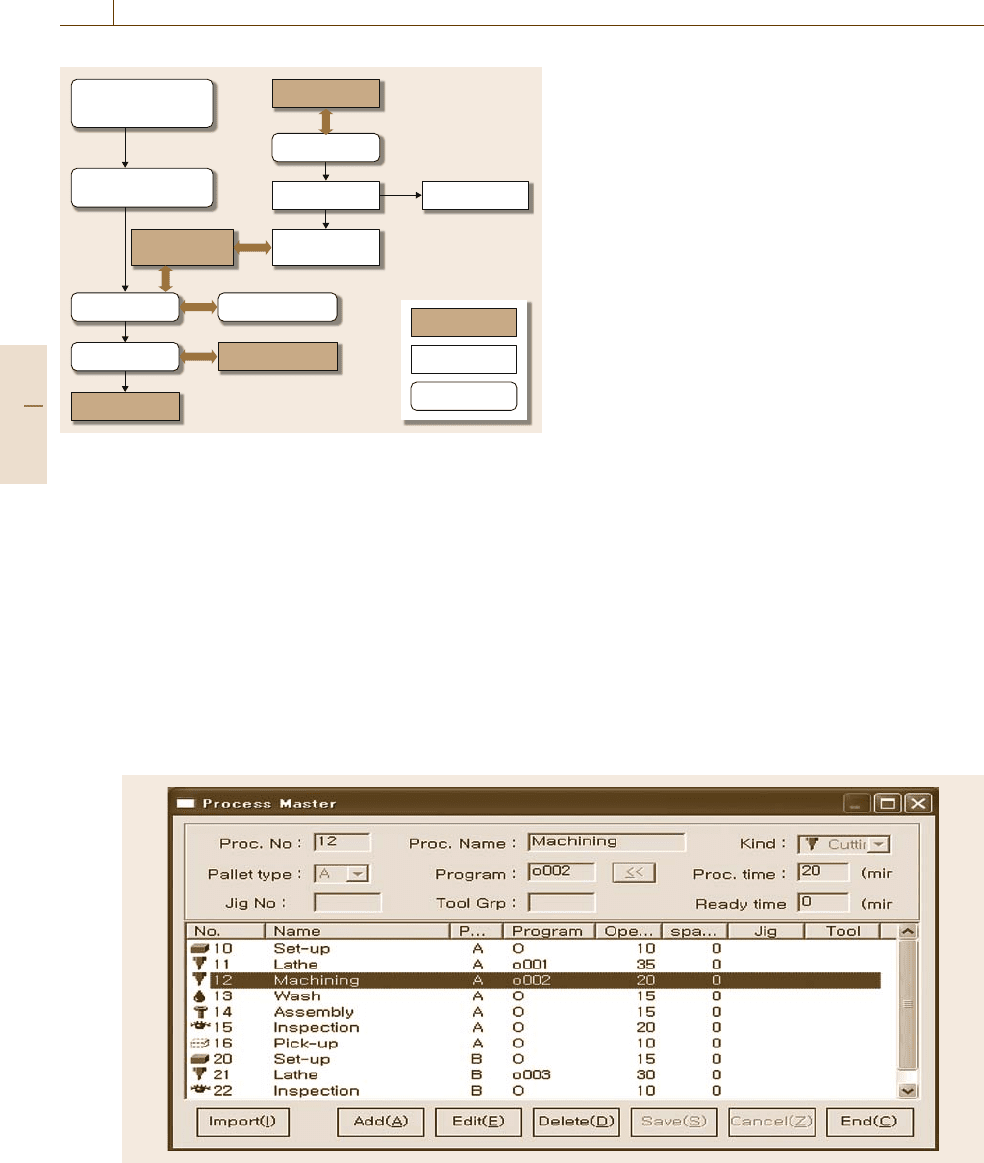
1520 Part I Home, Office, and Enterprise Automation
Contact from customer
Order selection
Process planning
Man-hour planning
Layout editor
Loading
analyzer
Equipment
master
Layout planning
Loading Master production
FMS simulatorScheduling
Gantt chart
Process master Part master
IT Jig
Database
Planning
Fig. 85.10 IT educational tool (IT jig) for production planning and
control
process control activities, which can be used to estab-
lish schedules and/or layout plans. These tools require
no special programming skills to use, and are easily
operated through the simple manipulation of icons.
Production Planning and IT Jigs Procedures. Process
control should be designed so as to enable effective
management of manufacturing processes and to max-
imize customer value creation. Effective processing of
order information is key to achieving this. The rela-
tionship between order information and process control
Fig. 85.11 Example process master screen
is summarized in Fig. 85.10, which depicts a series of
activities starting from the contact from the customer
to scheduling. Any uncertainties and/or nonconformity
in the process should be identified, which should then
be corrected, improved, and standardized in a timely
manner so as to ensure continuous improvement of pro-
cess control techniques. The roles of the layout editor
and FMS simulator [85.84], which are the IT edu-
cational tools (IT jigs) designed to help individuals
in the described planning process, are summarized in
Fig.85.10.
Creating the Process Master. The process master in
Fig.85.11 is created by determining the types (installa-
tion, cutting, cleaning, etc.) and number of processes to
be handled by the processing facilities (machining cen-
ters (M/Cs), lathes, inspection machines, etc.), and by
inputting a series of process information (1–7 below)
and the processing procedures. Appropriate machines
and equipment should be selected beforehand for the
processing facilities using Layout Editor. Process infor-
mation series 1–5 areidentified during processplanning
and process information series 6 and 7 are identified
during man-hour planning:
1. Process number: assigned toeach process.The same
number should not be used twice. The process num-
ber is equivalent to a process address.
2. Process name: a description of the specific process,
e.g., injection, drilling, threading, etc., or process 1,
process 2, etc.
Part I 85.2
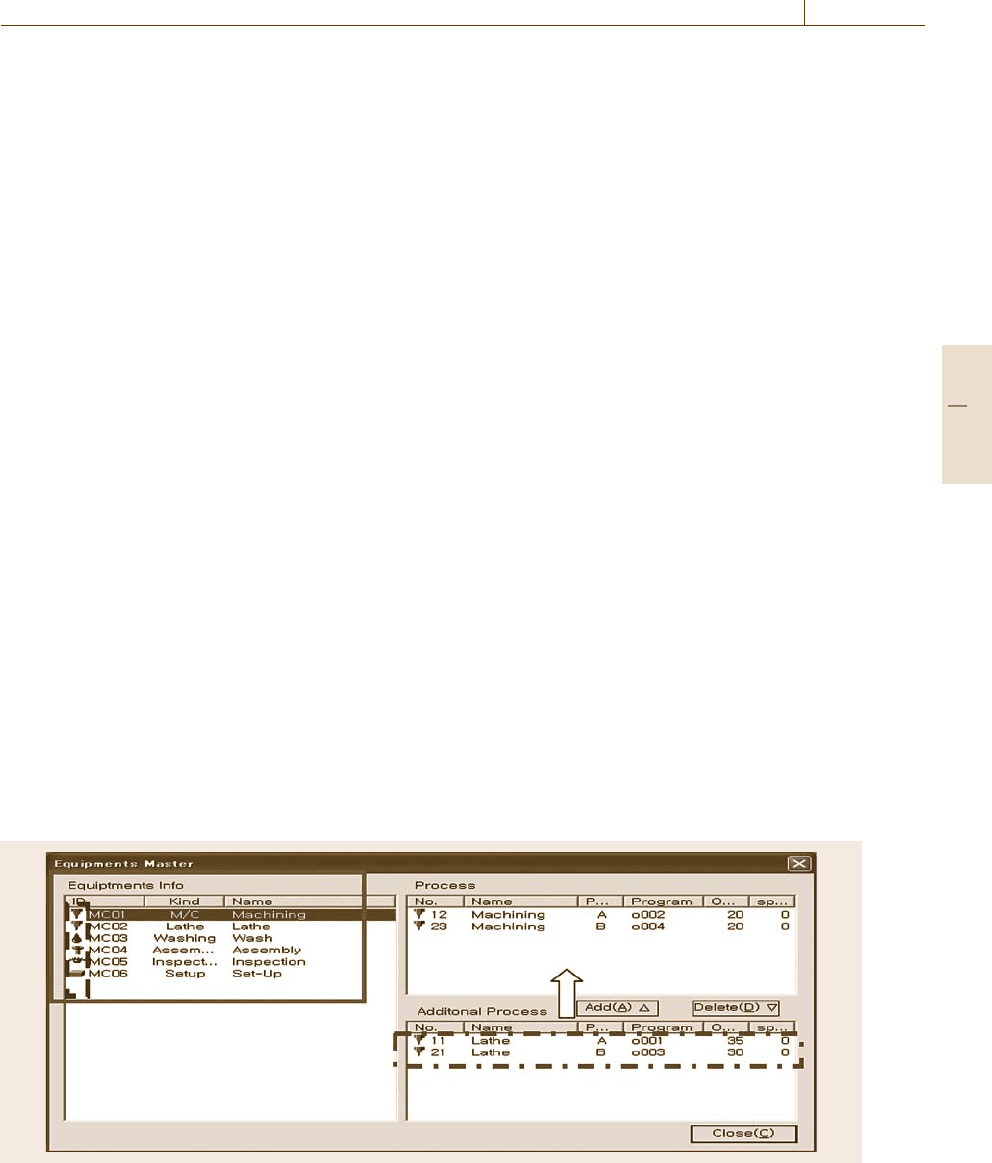
Automation in Education/Learning Systems 85.2 Examples 1521
3. Process type: there are six categories, namely instal-
lation, cutting, cleaning, assembly, inspection, and
removal. For more details, refer to the description
provided later in the chapter.
4. Palette type: a tool that resembles a tray, which is
used to transfer work pieces to each process.
5. Program: numerically controlled machine tools(NC
machine tools) are controlled using a processing
program. This information should be entered only
when the process type is cutting.
6. Processing time: the timerequired tohandle the pro-
cess, which is estimated either during the design
phase or based on experience.
7. Nonprocessing time: the time required for opera-
tions that do not involve the processing of work
pieces, i.e., setup or replacement of a processing
program and/or preparation of the necessary equip-
ments and materials.
An example process master screen is shown in
Fig.85.11.
Creating the Equipment Master. The equipment mas-
ter shown in Fig. 85.12 is a master file that determines
and allocates the appropriate equipment for performing
the kinds of process selected using the process mas-
ter (Fig.85.11). In short, users can identify the load
for each facility by creating an equipment master. The
equipment selected using the layout editor is automat-
ically listed in the equipment information pane shown
inside the solid lined box in Fig.85.12, and the symbol
representing the process type is listed beside the se-
lected equipment in the ID column, as shown inside the
dotted lines. If you click on machining in the equipment
Fig. 85.12 Example allocation results screen
information pane, allthe processesfor whichcutting has
been selected as the process type using process mas-
ter will be listed in the processes that can be added
pane as shown inside the dotted-line of additional pro-
cess. From the list of processes that can be added, select
the process to be allocated to machining (MC01)and
then click on add (allocate). In Fig. 85.12, processes
to be allocated are being selected (with four processes,
designated as either machining or lathe as the avail-
able processes). Figure 85.12 shows that a total of two
processes (process numbers 12 and 23) designated as
machining have been selected for allocation.
When an item is selected from the list displayed
in the equipment information pane, only the processes
belonging to the same process type (specified using
[process type] in process master) are displayed in the
processes that can be added pane.
Creating the Parts Master. The parts master shown
in Fig.85.13 is a master file used to manage the de-
livery schedule for each part and product. This is
accomplished using a process list created with the
process master, which consists of a list of selected
parts/products as well as of a series of related processes,
to assign appropriate process(es) to each part/product.
For example, Parts-C has the five process operations
from number 30 to 34 in Fig.85.13. Production sched-
ules canbe prepared by combining production plan with
the information provided in the parts master.
The creation of the three masters described above
is an important decision-making process that connects
process design (ranging from procedure planning to
load planning for each process) to process control.
In most companies, process control knowhow accu-
Part I 85.2
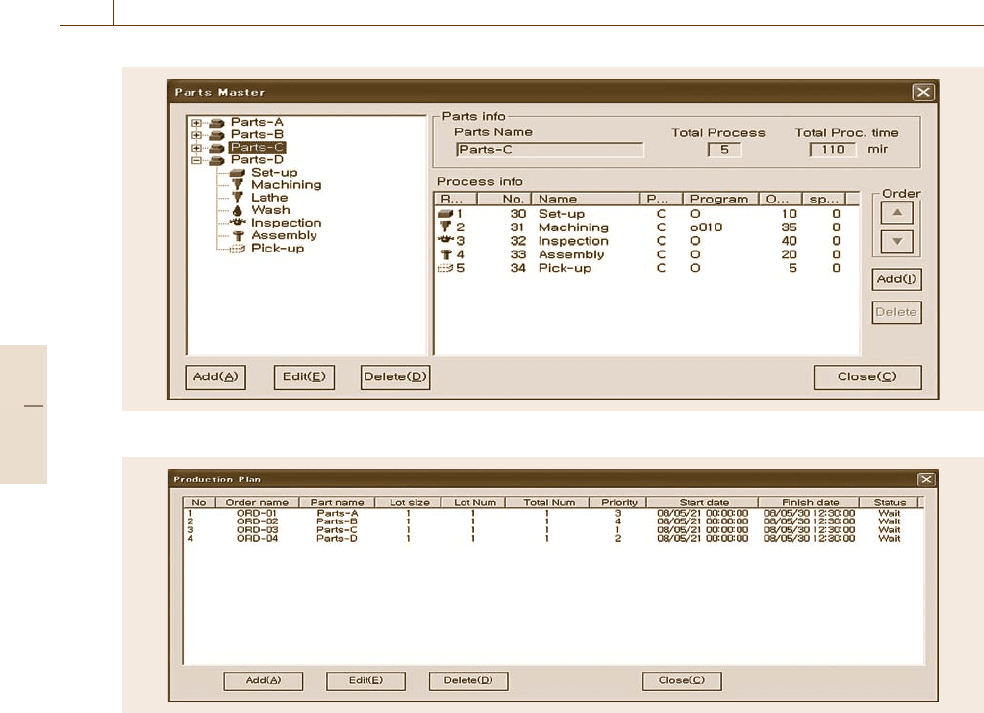
1522 Part I Home, Office, and Enterprise Automation
Fig. 85.13 Processes allocated for Parts-C using part master
Fig. 85.14 Example of a master production plan
mulated through years of experience is often neither
documented in manuals nor shared through information
systems. In view of this, it is important to involve oper-
ators working on site in the process of creating the three
masters so as to identify and incorporate all the process
control knowhow accumulated in-house.
Master Production Plan and Scheduling. Figure 85.6
presents the master production plan window showing
a list of the orders received in a planning period, the
items to be manufactured, and the time required for
the production of each item. Production schedules are
established based on this informationand the three Mas-
ters. The parts name column shows a total of fore items:
Parts-A (order number 01), Parts B (order number 02),
Parts-C (order number 03), and Parts-D (order num-
ber 04), which are to be included in the production
plan. The following information can be derived from the
plan.
The start date and time and finish date and time
show when production should be completed. Start date
and time refers to the date and time when production
can be initiated. Assuming that all the necessary mater-
ials are ready and available for production, start date
and time is either one of the following:
•
The date and time when the order is received, if
dynamic scheduling is used
•
The date and time when the plan is finalized, if
periodic scheduling is used.
When there is advanced knowledge that the arrival of
some of the materials will be delayed, the date and time
when all the materials will arrive should be set as the
date and time when production can be initiated.
Figure 85.15 provides an example of a Gantt
chart created using the dispatching rule (first-in first-
out, FIFO) retrieved from the FMS simulator. Besides
Part I 85.2
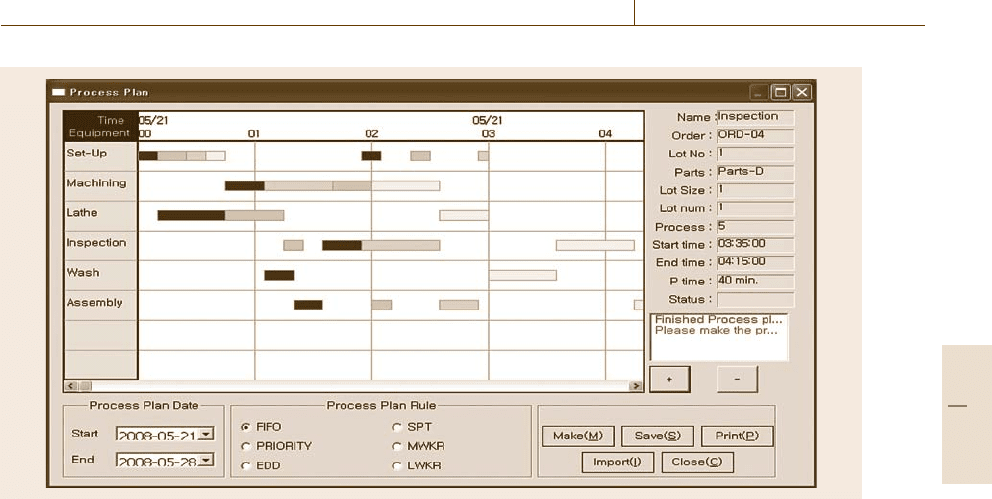
Automation in Education/Learning Systems 85.3 Conclusions and Emerging Trends 1523
Fig. 85.15 Example FMS schedule Gantt chart scheduled by FIFO
FIFO, earliest due date (EDD), most work remaining
(MWKR), and other dispatching rules are also available
in the FMS simulator menu as well as some schedul-
ing parameters with automated guided vehicle (AGV).
Users can simulate scheduling either by using one of
these dispatching rules or by creating their own unique
dispatching rules as well as production/handling lot
size, buffer stock size, and material handling schedule,
and then assessing the simulation results. The simulator
is designed to provide users with practical knowhow on
scheduling, and offers useful tips on effective schedul-
ing and process control.
85.3 Conclusions and Emerging Trends
This chapter has considered the automation of educa-
tion/learning systems with an overview of the devel-
opment history and present conditions of e-Learning
based on instructional design, and introduced exam-
ples of manufacturing management personnel programs
in management systems and industrial engineering
(IE). For additional information on the automation of
education see Chap.44. In this final section, as a con-
clusion, we present the issues and outlook for the
automation of education/learning systems, centered on
e-Learning.
If education/learning systems aim at creating new
social value for enterprises and communities by draw-
ing together individual value creation activities [85.85,
86], e-Learning is one systematic approach for the use
of information and communications technology in ed-
ucation/learning systems. Much of the development of
e-Learning to date has focused on basic arrangements
as an effective means to make conventional education
and learning methods more efficient and convenient,
and some accomplishments have been realized [85.87].
Considering the future outlook based on these achieve-
ments, e-Learning has the potential to more directly
link personal value creation to social value. In other
words, e-Learning can directly tie education/learning
activities to the formation of business results and so-
cial capital [85.88, 89]; for example, e-Learning can
go hand in hand with knowledge management, sales
force management, human resources management, en-
terprise information portals, electronic performance
support systems,and community service. The value cre-
ated from such activities will mostly take the form of
intellectual assets, with intellectual value, unlike the
conventional material value of the past [85.90–98]. This
intellectual asset formation is an effort aimed at the ac-
quisition, understanding, and creation of explicit and
tacit knowledge [85.73] that transcends the restrictions
of space and time.
Part I 85.3

1524 Part I Home, Office, and Enterprise Automation
Given this outlook, the future development of
e-Learning-related technologies will likely include the
following areas:
1. Technological development issues:
a) Development and application of user-interface
technology to secure human-friendly communi-
cations such as mailing lists,bulletinboards, and
machine translation
b) Response analysis by effective tools and soft-
ware such as simulation, groupware, virtual
reality for analysis of natural language, numeri-
cal expressions, etc.
c) Development and application of 3-D online vir-
tual presentation mechanisms such as Second
Life [85.99]
d) Introduction of expert systems.
2. Man–machine systems issues:
a) Solution for incompletion of learning man-
agement system (LMS) functions from the
following points:
· Secure and maintain learner motivation
· Measures when there are learning deficien-
cies to control teaching and learning process
· Construction of new dynamic evaluation
systems
· Open systems.
b) Limitations of teaching methods (instructor–
learner partnership, collaboration).
Implement the following measures to develop
systems where instructors and learners can
jointly embody the truth that teaching is learn-
ing:
· Public disclosure of good practices
· Instructor training
· Development of teaching methods.
c) Cost-reduction effectiveness:
· Resolution of intellectual property issues.
Diverse e-Learning educational materials
and contents are developed, produced, and
administered through the hands of many
stakeholders. This demands the develop-
ment of systems and management technolo-
gies that protect the rights of these value
creators and also enhance the convenience of
learners and other users.
· Developmentof socialcapital fore-Learning.
Collaboration among application service
providers (ASPs), educational institution
federations, government, and the private
sector to construct and upgrade social infra-
structure for rational costs.
3. Nurturing the e-Learning profession.
Development of systems to educate specialist per-
sonnel to effectively and efficiently advance the
series of activities of development, design,introduc-
tion, administration, and evaluation of e-Learning
systems to achieve the desired learning goals, and
development of technologies to evaluate these edu-
cational systems.
References
85.1 A.Toffler,H.Toffler:Revolutionary Wealth (Knopf
Borzoi Books, New York 2006)
85.2 P.B. Seybold, R.T. Marshak: The Customer Revolu-
tion (Crown Business, Danver 2001)
85.3 G.M. Piskurich: Self-Directed Learning: A Practical
Guide to Design, Development, and Implementa-
tion (Pfeiffer, Somerset 1993)
85.4 J.J. Pear, M. Novak: Computer-aided personalized
system of instruction: a program evaluation, Teach.
Psychol. 23, 119–123 (1996)
85.5 M. Ryder: Instructional design Models (2009),
http://carbon.cudenver.edu/˜mryder/itc_data/
idmodels.html
85.6 Applied Research Laboratory, Penn State Univer-
sity: Definitions of instructional design (2009),
http://www.umich.edu/˜ed626/define.html
85.7 K. Ishii, H. Ikeda, A. Tsuchiya, M. Nakano: De-
velopment of educational program for production
manager leading new perspectives on manufac-
turing technology, Proc. 19th ICPR, Valparaiso, Chile
(2007)
85.8 K. Ishii, T. Ichimura, S. Kondoh, S. Hiraki: An inno-
vative management system to create new values,
Int. J. Technol. Manag. 45(3/4), 291–305 (2009)
85.9 K. Suzuki: The instructional design for e-Learning
practice, Jpn. J. Educ. Technol. 29(3), 197–205
(2005), in Japanese
85.10 W.J. Rothwell, H.C. Kazanas: Mastering the In-
structional Design Process, 2nd edn. (Jossey-Bass,
Hoboken 1998)
85.11 G.M. Piskurich: Rapid Instructional Design: Learn-
ing ID Fast and Right (Jossey-Bass/Pfeiffer, Hobo-
ken 2000)
85.12 M.W. Allen: Michel Allen’s Guide to e-Learning:
Building Interactive, Fun, and Effective Learning
Programs for Any Company (Wiley, Hoboken 2003)
Part I 85
